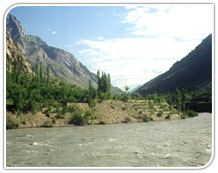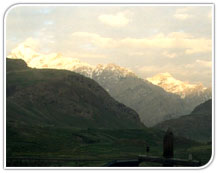Kargil
City Guide
 KARGIL (2704 m), 204 kms from Srinagar in the west and 234 kms from Leh in
the east, is the second largest urban centre of Ladakh and headquarters of
the district of same name. A quite town now, Kargil once served as
important trade and transit centre in the Pan-Asian trade network.
Numerous caravans carrying exotic merchandise comprising silk, brocade,
carpets, felts, tea, poppy, ivory etc. transited in the town on their way
to and from China, Tibet, Yarkand and Kashmir. The old bazaar displayed a
variety of Central Asian and Tibetan commodities even after the cessation
of the Central Asian trade in 1949 till these were exhausted about two
decades back. Similarly the ancient trade route passing through the
township was lined with several caravanserais. Now, since 1975, travellers
of numerous nationalities have replaced traders of the past and Kargil has
regained its importance as a centre of travel-related activities. Being
located in the centre of the Himalayan region with tremendous potentials
for adventure activities, Kargil serves as an important base for adventure
tours in the heart of Himalayas. It is also the take off station for
visitors to the erotic Zanskar Valley. Tourists travelling between
Srinagar and Leh have to make a night halt here before starting the second
leg of their journey.
KARGIL (2704 m), 204 kms from Srinagar in the west and 234 kms from Leh in
the east, is the second largest urban centre of Ladakh and headquarters of
the district of same name. A quite town now, Kargil once served as
important trade and transit centre in the Pan-Asian trade network.
Numerous caravans carrying exotic merchandise comprising silk, brocade,
carpets, felts, tea, poppy, ivory etc. transited in the town on their way
to and from China, Tibet, Yarkand and Kashmir. The old bazaar displayed a
variety of Central Asian and Tibetan commodities even after the cessation
of the Central Asian trade in 1949 till these were exhausted about two
decades back. Similarly the ancient trade route passing through the
township was lined with several caravanserais. Now, since 1975, travellers
of numerous nationalities have replaced traders of the past and Kargil has
regained its importance as a centre of travel-related activities. Being
located in the centre of the Himalayan region with tremendous potentials
for adventure activities, Kargil serves as an important base for adventure
tours in the heart of Himalayas. It is also the take off station for
visitors to the erotic Zanskar Valley. Tourists travelling between
Srinagar and Leh have to make a night halt here before starting the second
leg of their journey.
The town lies nestling along the rising
hillside of the lower Suru basin. Two tributaries of the Suru River that
meet here are the Drass and Wakha. The land available along the narrow
valley as also the rising hillsides are intensively cultivated in neat
terraces to glow barley, wheat, peas, a variety of vegetables and other
cereals. Kargil is famous for the fine apricots grown here. In May the
entire countryside becomes awash with fragrant white apricot blossoms
while August, the ripening fruit lends it an orange hue.
What
to See and Do
 Kargil mainly serves as an ideal base station for adventure activities
like trekking, mountaineering, camping, river rafting etc. In high
Himalayan Valleys. It is also a base for taking shorter excursions to
Mulbek where the chief attraction is a 9-m high rock sculpture depicting
the future Buddha. Kargil also offers some interesting walks along the
river bank and up the hillside. The best among these is the one leading to
Goma Kargil along a 2-km long winding road which, passing through some of
the most picturesque parts of the town, presents breathtaking views of the
mountain stream. A stroll in the bazaar might lead to a shop selling flint
and tobacco pouches, travelling hookahs and brass kettles - handcrafted
items of everyday use which find their way into the mart as curios. Most
shops deals in common consumer goods, but some specialize in trekking
provisions. The showroom of the Government Industries Centre near the
riverbank displays and sell Pashmina Shawls, local carpets and other
woolen handicrafts. The apricot jam produced here serves as a rare
delicacy. Kargil's dry apricot has now become a souvenir item, which can
be purchased freely in the bazaar.
Kargil mainly serves as an ideal base station for adventure activities
like trekking, mountaineering, camping, river rafting etc. In high
Himalayan Valleys. It is also a base for taking shorter excursions to
Mulbek where the chief attraction is a 9-m high rock sculpture depicting
the future Buddha. Kargil also offers some interesting walks along the
river bank and up the hillside. The best among these is the one leading to
Goma Kargil along a 2-km long winding road which, passing through some of
the most picturesque parts of the town, presents breathtaking views of the
mountain stream. A stroll in the bazaar might lead to a shop selling flint
and tobacco pouches, travelling hookahs and brass kettles - handcrafted
items of everyday use which find their way into the mart as curios. Most
shops deals in common consumer goods, but some specialize in trekking
provisions. The showroom of the Government Industries Centre near the
riverbank displays and sell Pashmina Shawls, local carpets and other
woolen handicrafts. The apricot jam produced here serves as a rare
delicacy. Kargil's dry apricot has now become a souvenir item, which can
be purchased freely in the bazaar.
Situated 45 kms East of
Kargil on the road to Leh, Mulbek (3230 m) in an area dominated by the
Buddhists. It is situated along either banks of the Wakha River, which
originates. Many monuments of the early Buddhists era dot the landscape
and are accessible from the road.
Mulbek Chamba : The
chief attraction of Mulbek is a 9 m high rock sculpture in deep relief of
Maitreya, the Future Buddha. Its excursion combines esoteric Shaivite
symbolism with early Buddhist art. Situated right on the highway, it dates
back to the period when Buddhists missionaries came travelling east of the
Himalayas.
Mulbek Gompa : Perched atop a rocky cliff,
Mulbek Gompa (monastery) dominates the valley. It is easy to see why in
bygone times this site served as an outpost to guard the caravan route.
Like all Buddhists monasteries it is adorned by frescoes and statues.
Shergol : Another picturesque village of the Wakha River
valley, Shergol is situated across the river, right of the Kargil-Leh
road. The main attraction is a cave monastery which is visible from a far
as a white speck against the vertically rising ochre hill from which it
appears to hang out. Below this small monastery is a larger Buddhist
nunnery with about a dozen incumbents. The village is accessible by the
motorable road that branches off from the Kargil-Leh road, about 5 km
short of Mulbek. Shergol is a convenient base for an exciting 4-day trek
across the mountain range into the Suru valley. It is also the approach
base for visiting Urgyan-Dzong, a meditation retreat lying deep inside the
mountains surrounding the Wakha River valley.
Urgyan Dzong
: This meditation retreat lies tucked away in an amazing natural
mountain fortress high up in Zanskar range. Concealed within is a circular
table land with a small monastic establishment at its centre. The
surrounding hillside reveals several caves where high-ranking Buddhists
saints meditated in seclusion. At least one such cave is associated with
the visit of Padmasambhava, the patron saint of Tibetan Buddhism. The main
approach is to footpath laid through the only gap available in the rocky
ramparts.
Wakha Rgyal : Tucked away inside the
picturesque upper part of the Wakha Valley, upstreams of Mulbek, Rgyal
gives the appearance of a medieval settlement of cave dwellings
transported in to the modern times with some improvements and extensions.
The houses, neatly white-washed and closely stacked, are dug into the
sheer face of a vertical cliff that rises high above the green valley
bottom. From a far the village looks like a colony of beehives hanging
from the ochre granite of the Cliffside.
KARGIL (2704 m), 204 kms from Srinagar in the west and 234 kms from Leh in the east, is the second largest urban centre of Ladakh and headquarters of the district of same name. A quite town now, Kargil once served as important trade and transit centre in the Pan-Asian trade network. Numerous caravans carrying exotic merchandise comprising silk, brocade, carpets, felts, tea, poppy, ivory etc. transited in the town on their way to and from China, Tibet, Yarkand and Kashmir. The old bazaar displayed a variety of Central Asian and Tibetan commodities even after the cessation of the Central Asian trade in 1949 till these were exhausted about two decades back. Similarly the ancient trade route passing through the township was lined with several caravanserais. Now, since 1975, travellers of numerous nationalities have replaced traders of the past and Kargil has regained its importance as a centre of travel-related activities. Being located in the centre of the Himalayan region with tremendous potentials for adventure activities, Kargil serves as an important base for adventure tours in the heart of Himalayas. It is also the take off station for visitors to the erotic Zanskar Valley. Tourists travelling between Srinagar and Leh have to make a night halt here before starting the second leg of their journey.
Kargil mainly serves as an ideal base station for adventure activities like trekking, mountaineering, camping, river rafting etc. In high Himalayan Valleys. It is also a base for taking shorter excursions to Mulbek where the chief attraction is a 9-m high rock sculpture depicting the future Buddha. Kargil also offers some interesting walks along the river bank and up the hillside. The best among these is the one leading to Goma Kargil along a 2-km long winding road which, passing through some of the most picturesque parts of the town, presents breathtaking views of the mountain stream. A stroll in the bazaar might lead to a shop selling flint and tobacco pouches, travelling hookahs and brass kettles - handcrafted items of everyday use which find their way into the mart as curios. Most shops deals in common consumer goods, but some specialize in trekking provisions. The showroom of the Government Industries Centre near the riverbank displays and sell Pashmina Shawls, local carpets and other woolen handicrafts. The apricot jam produced here serves as a rare delicacy. Kargil's dry apricot has now become a souvenir item, which can be purchased freely in the bazaar.